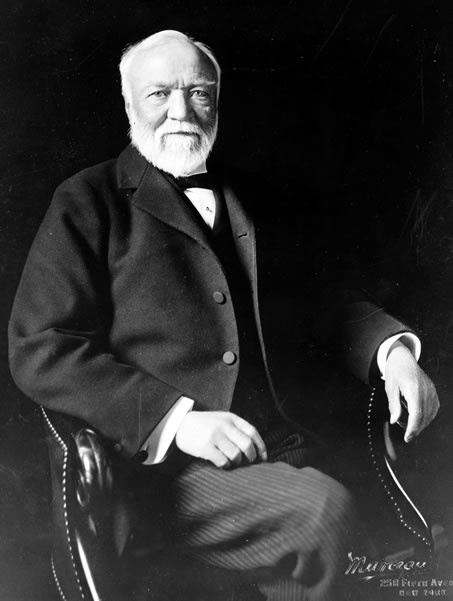
Andrew Carnegie in 1913.
Andrew Carnegie: Library philanthropist
Though he never visited or lived in New Zealand, the Scottish-born American businessman and philanthropist Andrew Carnegie left a lasting impression on the country. As part of his policy of establishing free libraries across the English-speaking world, he was responsible for funding 18 library buildings in New Zealand. After his death in 1919 the Carnegie Corporation of New York, which he had endowed, continued to contribute to the development of New Zealand's library service, most notably in the 1930s and 40s.
Andrew Carnegie was born in Dunfermline, Scotland, in November 1835. It was here that he had his first experience of a library - his father, a weaver, had helped create a local tradesmen's library in 1808. After hard times struck the weaving industry from the late 1830s, Carnegie's parents decided that the family should emigrate to the United States. They settled in Allegheny, Pennsylvania, in 1848 and Carnegie started his first job, working as a bobbin boy at a cotton mill. In 1850 he became a telegraph messenger boy in the Pittsburgh Office of the Ohio Telegraph Company. A hard worker, he was promoted to operator within a year.
Carnegie on his libraries
'If one boy in each library district, by having access to one of these libraries, is half as much benefited as I was by having access to Colonel Anderson's four hundred well-worn volumes, I shall consider they have not been established in vain.'
During this period Carnegie was granted access to another library. In 1849 a local businessman, Colonel James Anderson opened his private library of some 400 volumes to working boys on Saturday evenings. Carnegie reportedly read most of the books in the library, and never forgot Anderson's generosity. When new management tried to change the terms of entry in 1853, asking for subscriptions from boys like Carnegie who were not bound by letters of apprenticeship, he wrote to the local newspaper urging that they not be excluded. Eventually the library's management agreed to give these boys equal access.
That same year Carnegie entered the railroad industry as a secretary/telegraph operator for the Pennsylvania Railroad Company. He rapidly advanced through the company and began to invest in related industries. He left Pennsylvania Railroad in 1865 and, foreseeing future demand, began to focus his energy on iron and steel. In 1873 he established his first steel mill, the Edgar Thomson Steel Mill. It eventually evolved into the Carnegie Steel Company, which at its peak operated eight steel mills. On his retirement in 1901 Carnegie sold the company to banker J.P. Morgan for US$480 million. His personal share was more than $200 million.
Carnegie devoted the last two decades of his life to philanthropy. He never forgot the pleasure he had gained from Anderson's library and one of his first acts of philanthropy was to erect a free library in his home town, Dunfermline, in 1883. Building public libraries became a key feature of his philanthropic activities. In all, he was responsible for the erection of 2509 libraries in the United States, Britain and Ireland, Canada, the Caribbean, Australia, Fiji and New Zealand. Not all the 18 libraries erected in New Zealand with Carnegie's assistance abided by his condition that borrowing, and not merely admission, should be free. But they were nevertheless a valuable addition to the communities in which they were established.
In 1911 Carnegie, tiring of the burden of philanthropic decision-making - but still with a fortune of more than $150 million - endowed the Carnegie Corporation of New York with $125 million ‘to promote the advancement and diffusion of knowledge and understanding'. He continued to make most of the funding decisions, but also gave his trustees the flexibility to change the Corporation's policy or the causes aided when in their opinion it became ‘necessary or desirable'. A critical report saw the Corporation stop issuing new grants for the building of libraries from 1917 and, following Carnegie's death in August 1919, the focus of its library programme shifted to improving quality. In New Zealand this took the form of supporting librarians to study in the United States and Europe, particularly during the 1930s and 40s, and undertaking surveys into the state of the library service, notably the Munn Barr report of 1934.
Further information
Links
- Colonel James Anderson (Carnegie Library of Pittsburgh)
- Colonel James Anderson (History of the Andrew Carnegie Free Library and Music Hall)
- Andrew Carnegie (Wikipedia)
- Andrew Carnegie (Encyclopedia Britannica)
- Andrew Carnegie (National Park Service)
- Carnegie Steel Company (Wikipedia)
- Carnegie Library (Wikipedia)
- Carnegie Corporation of New York (Wikipedia)
- Carnegie Corporation of New York (Carnegie Corporation of New York)
- Carnegie Libraries (New Zealand Geographic)
Publications
- Peter Krass, Andrew Carnegie, John Wiley & Sons Inc, New Jersey, 2002.
- David Nasaw, Andrew Carnegie, Penguin Books, London, 2006.

Community contributions